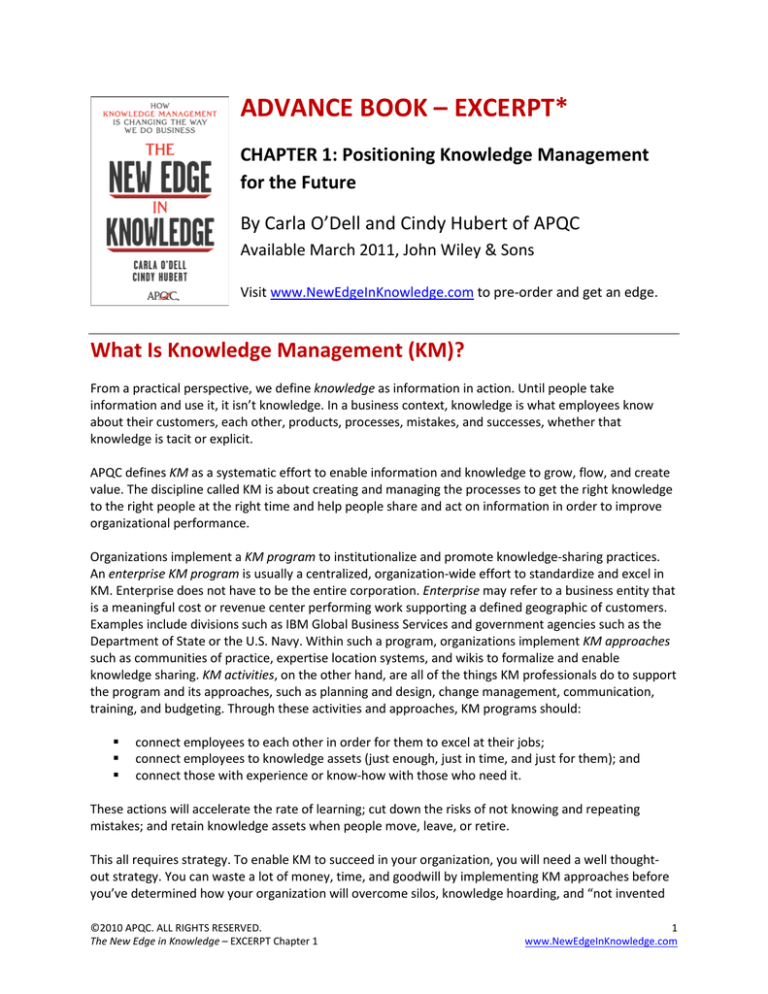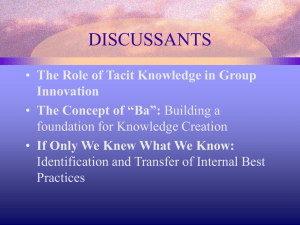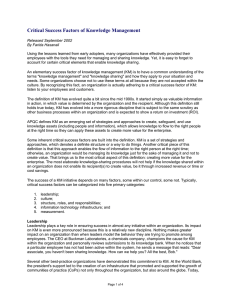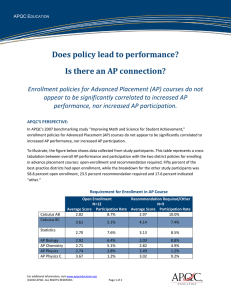
ADVANCE BOOK – EXCERPT*
CHAPTER 1: Positioning Knowledge Management
for the Future
By Carla O’Dell and Cindy Hubert of APQC
Available March 2011, John Wiley & Sons
Visit www.NewEdgeInKnowledge.com to pre-order and get an edge.
What Is Knowledge Management (KM)?
From a practical perspective, we define knowledge as information in action. Until people take
information and use it, it isn’t knowledge. In a business context, knowledge is what employees know
about their customers, each other, products, processes, mistakes, and successes, whether that
knowledge is tacit or explicit.
APQC defines KM as a systematic effort to enable information and knowledge to grow, flow, and create
value. The discipline called KM is about creating and managing the processes to get the right knowledge
to the right people at the right time and help people share and act on information in order to improve
organizational performance.
Organizations implement a KM program to institutionalize and promote knowledge-sharing practices.
An enterprise KM program is usually a centralized, organization-wide effort to standardize and excel in
KM. Enterprise does not have to be the entire corporation. Enterprise may refer to a business entity that
is a meaningful cost or revenue center performing work supporting a defined geographic of customers.
Examples include divisions such as IBM Global Business Services and government agencies such as the
Department of State or the U.S. Navy. Within such a program, organizations implement KM approaches
such as communities of practice, expertise location systems, and wikis to formalize and enable
knowledge sharing. KM activities, on the other hand, are all of the things KM professionals do to support
the program and its approaches, such as planning and design, change management, communication,
training, and budgeting. Through these activities and approaches, KM programs should:
connect employees to each other in order for them to excel at their jobs;
connect employees to knowledge assets (just enough, just in time, and just for them); and
connect those with experience or know-how with those who need it.
These actions will accelerate the rate of learning; cut down the risks of not knowing and repeating
mistakes; and retain knowledge assets when people move, leave, or retire.
This all requires strategy. To enable KM to succeed in your organization, you will need a well thoughtout strategy. You can waste a lot of money, time, and goodwill by implementing KM approaches before
you’ve determined how your organization will overcome silos, knowledge hoarding, and “not invented
©2010 APQC. ALL RIGHTS RESERVED.
The New Edge in Knowledge – EXCERPT Chapter 1
1
www.NewEdgeInKnowledge.com
here” resistance. You can waste even more of your organization’s resources by simply adopting an IT
tool and calling it a KM program. (Technology alone will not ensure engagement and value.) Let us help
you position KM in the sweet spot of knowledge and business strategy. We know what works.
KM in a New Context
One of us—Carla—wrote her first book on how to implement KM, If Only We Knew What We Know, in
1998 when the discipline was less than a decade old (Grayson and O’Dell).
What a difference a decade makes. Witness 9/11, the Iraq and Afghanistan wars, the rise of China as a
superpower, global warming, the near meltdown of the global financial system in 2008 and 2009, and
the Gulf of Mexico oil rig explosion and resulting pollution in 2010.
The changes are just as substantial as we edge closer to the realm of KM: rising Internet and broadband
access, the explosion of mobile devices and smart phones, the continued rise in virtual work and global
teams, the international equalization of competitive prowess and knowledge, the decline of readership
for the printed word, the rise of digital readership, and on and on.
It would be hard to overstate how profoundly these developments have both challenged and enhanced
the promise and practice of KM. KM’s core objectives haven’t changed, but how we accomplish them
has. In this section, we zoom in on the forces affecting organizations and KM now and for years to come.
We offer advice throughout this book to deal with them.
Force 1: Digital Immersion
We are experiencing the incursion of the Internet and digital technology into almost every aspect of our
lives. Wireless connections and mobile devices have made the Internet available from almost anywhere,
and ever-increasing bandwidth has enabled the rise of streaming video and other high-impact content.
Employees of all ages spend 70, 80, or even 90-plus hours a week in front of laptops and smart phones,
conducting a mix of professional and personal business. Expectations of 24/7 connectivity are affecting
the way we work and live.
Many people are comforted by the feeling that they’re always getting things done—responding to emails in meetings, taking calls in line at the supermarket, and so on. But that feeling may be an illusion.
Are today’s employees as savvy as they appear at multitasking? Not according to Clifford Nass, a
professor at Stanford University and the director of the Communication Between Humans and
Interactive Media Lab. His data suggests that even the brightest people are hampered by an
unwillingness (or inability) to focus on one thing at a time. Nass and his research team predicted that
multitaskers might be good at three things:
1. Filtering. Focusing on what’s relevant while ignoring distractions and extraneous information.
2. Switching. Moving between tasks quickly and getting up to speed with a minimum amount of
ramp-up time.
3. Organizing their memories. Transferring information from short-term to long-term memory to
ensure that important facts are retained.
©2010 APQC. ALL RIGHTS RESERVED.
The New Edge in Knowledge – EXCERPT Chapter 1
2
www.NewEdgeInKnowledge.com
But his research results then indicated the opposite: “It turns out multitaskers are terrible at every
aspect of multitasking,” Nass writes. “They’re terrible at ignoring irrelevant information; they’re terrible
at keeping information in their head nicely and neatly organized; and they’re terrible at switching from
one task to another” (2010).
Even more disturbing, almost all the research participants thought they were good at these aspects of
multitasking.
If you are familiar with Lean manufacturing techniques, you know that set-up time does not add value.
And when you switch what you are working on, there is set-up time. HP research indicates it can take 15
minutes to fully reset your focus after an interruption (Friedlander). You are not actually multitasking.
Instead, you toggle between tasks and lose start-up time every time you switch back. And there is a
good possibility that you will forget something before you get back to it.
The findings are clear: While supposedly getting more done in less time through our immersion into
digital technology, we are actually working more slowly, absorbing information less effectively, and
hampering our capacity for analytic reasoning.
A study by the University of California, Irvine found that the average professional switches between
work activities every three minutes and five seconds (Pattison 2008). A similar study involving Microsoft
employees reinforced that, when employees were interrupted by e-mail or instant messages, it took
them an average of 15 minutes to return to more complex mental tasks like computer programming or
writing reports (Lohr 2007). This kind of multitasking decreases productivity while increasing stress and
feelings of overload (Lohr 2007). “When people are switching contexts every [few] minutes, they can’t
possibly be thinking deeply,” writes Professor Gloria Mark of the University of California, Irvine (Lohr
2007).
If we don’t have any choice and we’re going to hire (and even encourage) multitaskers, then what kind
of KM scaffolding are we going to need to create to get thoughtful work done? We must adapt content
and messages to align with employees’ time and attention limitations. For KM, the implications are that:
1.
2.
3.
4.
We should assume employees are multitasking.
It isn’t making them perform better or pay attention to everything they see.
We shouldn’t design KM approaches that interrupt employees any more than they already are.
Even if a piece of information or knowledge is critical to retain, we can’t assume employees will
remember it when they need it. It has to be there at the teachable moment.
Force 2: Social Computing
Nearly one-fourth of the world’s 1.8 billion Internet users have profiles on social networking sites such
as Facebook, LinkedIn, and MySpace (Miniwatts 2009). And 75 million are signed up on Twitter (Gaudin
2010). LinkedIn, the networking site for professionals, has more than 70 million users (Rao 2010).
Facebook alone will likely exceed 600 million users by 2011. To put this number into perspective, if
Facebook were a country, it would be the third most populous after India and China (The Economist
2010). Even more staggering, in just one month, Facebook users post more than 3.5 billion pieces of
content.
©2010 APQC. ALL RIGHTS RESERVED.
The New Edge in Knowledge – EXCERPT Chapter 1
3
www.NewEdgeInKnowledge.com
With that much practice, it’s no surprise that employees feel at ease with social networking tools. Social
computing, Web 2.0, and the rise of social media are transforming KM. It is so good for KM that if we
didn’t have it, then we would have to invent it.
We define social media as Internet technology that allows people to generate content and interact in a
way that creates new information and value. Social media becomes social computing when applied to a
noncommercial intent among people to share and co-create. As Forrester Research explains it, “Web 2.0
is the building of the interstate highway system in the 1950s; social computing is everything that
resulted next (for better or worse): suburban sprawl, energy dependency,” etc. (Li 2006). And Web 2.0
tools are specific technologies that are relatively easy to adopt and master. From these developments
come Enterprise 2.0 applications, which tailor social media for business by addressing privacy concerns
and helping to align a wealth of internal knowledge and information sources within organizations and
thus enable social computing.
A defining feature of social computing is the reliance on the employee—not the organization—to create,
share, rate, and consume content. Simply by having the means to do so, each employee can be an
author, arbiter, and consumer at once.
A second defining feature of social computing is that the content improves the more people interact
with and build on it. Wikis and open innovation sites work best when informed people contribute;
ratings are arguably better and more accurate the more people contribute; metatags are more useful
the more they are applied; folksonomies can rival corporate taxonomies when many people tag and rate
content; and good sites and documents rise to the top of search requests the more often people
bookmark them and share those bookmarks.
We believe social computing tools are reinvigorating KM by making it easier for employees to participate
in knowledge creation while showing them the value of sharing with an online network of peers. By
borrowing ideas from Facebook, organizations have been able to help employees connect across
disparate regions. Similarly, sites like Wikipedia have popularized ways to collaborate and co-author
content. Since a majority of employees are already familiar with the features and have seen their value,
it is easier to build buy-in and may be easier to drive participation.
Many organizations—especially those in government and in highly regulated industries—continue to be
extremely concerned with the ramifications of these barrier-crushing applications. For example,
standards around trust are relaxing when it comes to the democratization of information and opinion.
And social computing is altering the determination of who are experts. But the most pressing concerns
surround security and privacy: what stays behind the firewall and what employees actually share with
each other and the world at large. KM professionals must find ways to capitalize on the positive aspects
of these new technologies while addressing these concerns.
Another key concern is how employees participate. Social computing works when enough people
participate. And participation has historically has been the biggest challenge for KM. We see an
important, sobering parallel in terms of content contribution.
On Facebook, 80 percent of the content is posted by 20 percent of users.
Only one in five Twitter accounts holders have ever posted anything, and 90 percent of content
is posted by 10 percent of the users (Moore 2010).
©2010 APQC. ALL RIGHTS RESERVED.
The New Edge in Knowledge – EXCERPT Chapter 1
4
www.NewEdgeInKnowledge.com
Keep those statistics in mind when thinking about participation rates for KM approaches using Web 2.0
tools inside your organization. A small percentage of people are the core contributors of content. Even
popular social computing approaches require KM professionals to marshal an effective KM strategy and
infrastructure to elicit engagement.
Force 3: Demographics and Dynamics
We could get so caught up in the hype around generational differences at work (which may not be that
great) that we may be overlooking the elephant in the room: retirement of the huge baby boomer
generation. Many organizations face looming knowledge retention and transfer issues, regardless of
industry, annual revenue, or their number of employees.
The retirement of a record 77 million baby boomers has the potential to result in huge losses of critical
tacit knowledge, including the loss of organizational and technical knowledge on key processes and
competencies. And churn from organizational reorganizations, rapid growth, layoffs, internal
redeployments, and new business models for offshoring work require just as much careful identification
and transfer of knowledge. We’ve also seen skilled employee shortfalls in key disciplines and time-tocompetency issues for those entering the work force. Employees—especially new hires—face steeper,
longer learning curves at the same time that employers are looking for faster revenue and higher
productivity.
The scarcity of talent will be a driving force in KM. “Fewer younger people will be working to support a
significantly larger older generation in the future,” PricewaterhouseCoopers writes. “Millennials will be a
powerful generation of workers” (2007).
Despite the handwringing every generation expresses about the next one, since the beginning of the
industrial revolution every generation has been more productive than the last. Innovative technologies
along with education and free market models have been the reason. Organizations will also benefit from
incoming generations’ increased desire to share knowledge (PricewaterhouseCoopers 2007).
KM needs to adapt to these evolving demographics and power dynamics. We’re just seeing the first
wave of a much larger phenomenon. Employees increasingly expect more engagement and information
and want to achieve it in the same way they do in their personal lives.
Force 4: Mobile Devices and Video
The tagline “We have an app for that” has entered our lexicon, and everyone seems to be perpetually in
a “Crackberry” prayer mode or immersed in their iPhone to the exclusion of all else. So what? Smart
phones have been around a long time. There are well-established company policies and precedents for
how to manage security; who pays for the device and its text, voice, and data charges; how to ensure
the security of information; and how the IT organization can establish, manage, and integrate the whole
system.
What are not well-established are guidelines for KM professionals to capitalize on this ubiquitous,
addictive pocket computer. What is appropriate to share through that tiny screen? How much do
employees want to know, and when do they want to know it? What can we learn from RSS, alert
systems, and Twitter to communicate with employees?
©2010 APQC. ALL RIGHTS RESERVED.
The New Edge in Knowledge – EXCERPT Chapter 1
5
www.NewEdgeInKnowledge.com
We also believe the future belongs to streaming video, and KM will benefit. Too expensive until now,
cheap digital video is now literally in the hands of millions of people. YouTube and big bandwidth have
made video a feasible and desirable medium for millions of average people to teach, learn, and share.
Demands to “show me, don’t tell me” make video far superior to text for communicating something
physical (e.g., how to open a banana like a monkey). It is also terrific for communicating emotion. Now
the buzz is to use it for a wide range of internal communication and not just the annual CEO speech.
Yet many if not most organizations block access to YouTube. It’s a quixotic effort, considering the
sophistication of the personal devices employees have at their disposal. Organizations—and KM
programs—would benefit by instead taking advantage of employees’ comfort and familiarity with
mobile devices and streaming video. In time, more powerful enterprise applications will be developed
for mobile devices and streaming video, which will expand the power of these tools for finding and
sharing information.
These are some of the major forces at work on KM today. We maintain that KM can help the digitally
induced, shrinking-attention-span, socially networked, information overloaded, smart phone-obsessed,
and busy knowledge worker of today.
About the Book
The New Edge in Knowledge: How Knowledge Management Is Changing the Way We Do Business
provides a strategy to ensure your organization has the knowledge it needs in the future and the ability
to connect the dots and use knowledge to succeed today. In the book, you will learn how to:
• Understand the core strategic issues in making KM successful.
• Build a business case using examples from leading organizations.
• Make sure your organization’s KM strategy is not missing a critical element.
• Take advantage of practical and proven advice from hundreds of research and advisory efforts.
KM was put on the map as a management discipline with the bestseller If Only We Knew What We
Know, co-written by APQC President Carla O’Dell. A decade later, O’Dell and APQC Executive Director
Cindy Hubert have written this definitive follow-up work.
Straightforward and comprehensive, The New Edge in Knowledge is based on APQC’s 20 years of
experience in KM benchmarking, best practices, and implementation with leading organizations globally.
The case studies and examples show how best-practice organizations achieve success with KM.
Visit www.NewEdgeInKnowledge.com to pre-order and get an edge.
About APQC
APQC is a member-based nonprofit and one of the world’s leading proponents of benchmarking, best
practices, process improvement, and knowledge management business research. Working with more
than 500 organizations worldwide in all industries, APQC is focused on providing organizations with the
information they need to work smarter, faster, and with confidence. For questions about APQC or our
KM resources or services, please visit www.apqc.org or call (800) 776 9676 or +1 (713) 681 4020.
* ©2011 American Productivity & Quality Center. ALL RIGHTS RESERVED. Published by John Wiley & Sons, Inc. No part of this publication may
be reproduced, stored in a retrieval system, or transmitted in any form or by any means, electronic, mechanical, photocopying, recording,
scanning, or otherwise, except as permitted under Section 107 or 108 of the 1976 United States Copyright Act, without either the prior written
permission of the Publisher, or authorization through payment of the appropriate per-copy fee to the Copyright Clearance Center, Inc., or on the
Web at www.copyright.com.
©2010 APQC. ALL RIGHTS RESERVED.
The New Edge in Knowledge – EXCERPT Chapter 1
6
www.NewEdgeInKnowledge.com




